Alice Morey
MEWO Kunsthalle Memmingen
by Alke Heykes
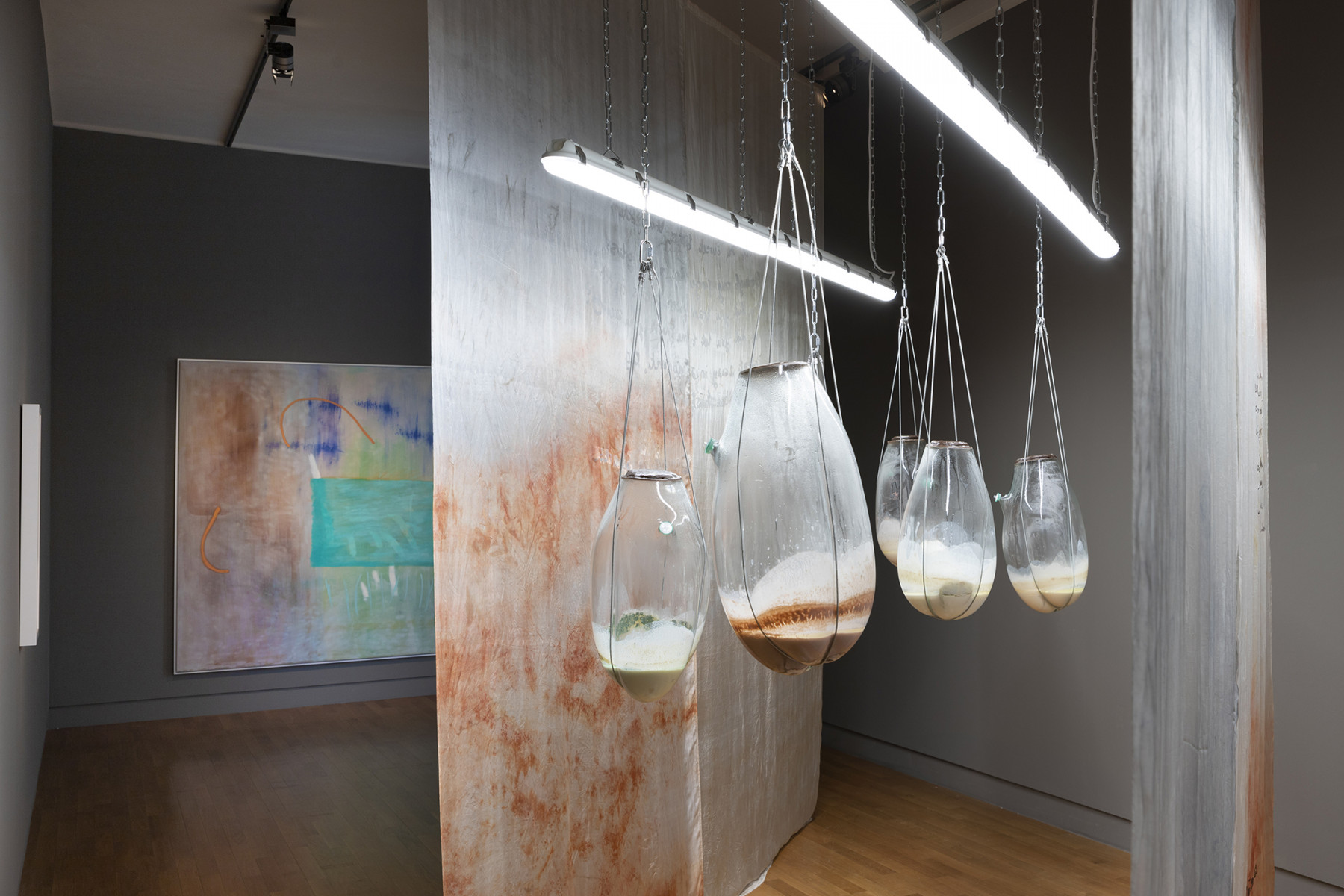
Alice Morey, Conditioning Demands, 2022, MEWO Kunsthalle Memmingen. Installation view. Photography: Sebastian Bühler.
The exhibition Conditioning Demands by British artist Alice Morey at MEWO Kunsthalle in Memmingen begins with a human breath. Six mouth-blown, amorphous glass vessels, resembling oversized test tubes, hang from the ceiling at eye level on wire ropes. These glass containers mark the beginning of a transformation process that puts human’s superior role in planetary existence into question. All vessels are sealed with wax and equipped with a valve on the side. The bottom is covered with a milky, semi-liquid, almost powdery substance. Cylindrical shapes protrude from the shimmering substance, and its surface is covered with turquoise, yellow, pink and brown fungi, furries and spores. The moisture, spores, and faint smell of fermentation hover in and around the vessels. Like a sterile experimental setup, Morey has infused each tube with probiotics from yoghurt, skyr, and buttermilk; pigments from natural minerals, such as red ochre, malachite, and lapis lazuli; and rolled canvas.
In her first institutional solo exhibition, Morey focuses on the particles and processes that shape and transform life; the microscopic, the metabolic, the unseen and unnoticed: "I count in Spores". The glass vessels frame the fermentation process of bacteria, fungi and enzymes. Moisture settles on the glass, mould spreads on the canvas, spores float through the air, and the bacteria and enzymes silently and secretly exist. After the breath has given the impetus for these processes, Morey steps back, and shares authorship with these complex life forms in her created ecosystem, highlighting processes that are often misunderstood as decay instead of growth and recreation.
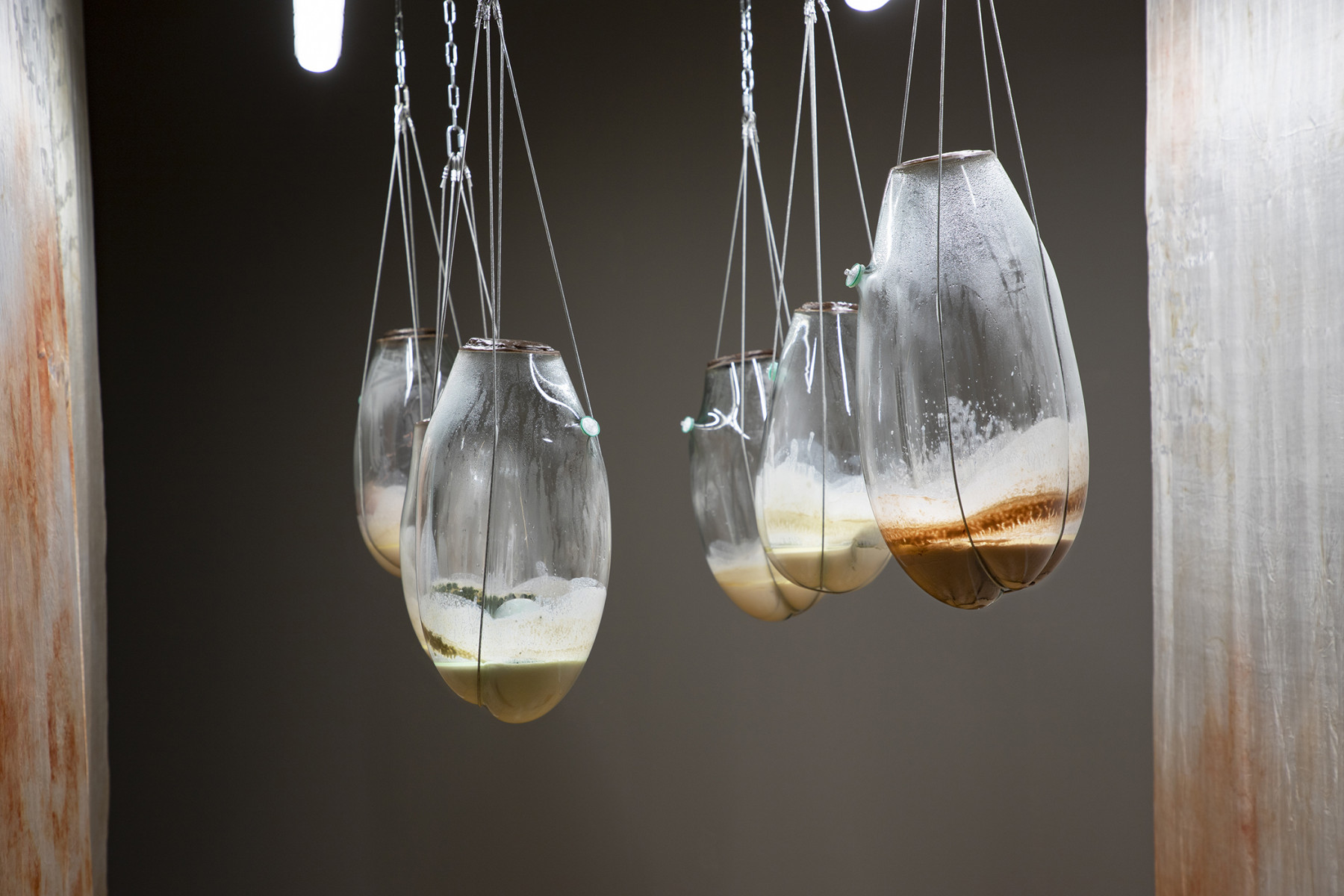
Alice Morey, Conditioning Demands, 2022, Mouth-blown glass, pigments (aegirine, cinnabarite, cavansite, red ochre, malachite, lapis lazuli), canvas, lactic acid bacteria, yoghurt, buttermilk, skyr, lime juice, wax, microfilter, metal wire, chains, hand-dyed silk with screen-printed text. Intallation view, Conditioning Demands, 2022, MEWO Kunsthalle Memmingen. Photography: Sebastian Bühler.
The human breath that gave the vessels their shapes continues to swirl through the exhibition, softly setting in motion the two hand-dyed silk curtains that flank the eponymous installation on either side of the vessels. Morey screen-printed these silk drapes with lyrical texts that read:
„I count in Spores.
Taste the sweet buds, that filter
through my fingertips & into glass.
How did you transform to this Earth?
How did you let time push you away?
Swept away in a moment, of
Complicated history.
I count in Spores.“
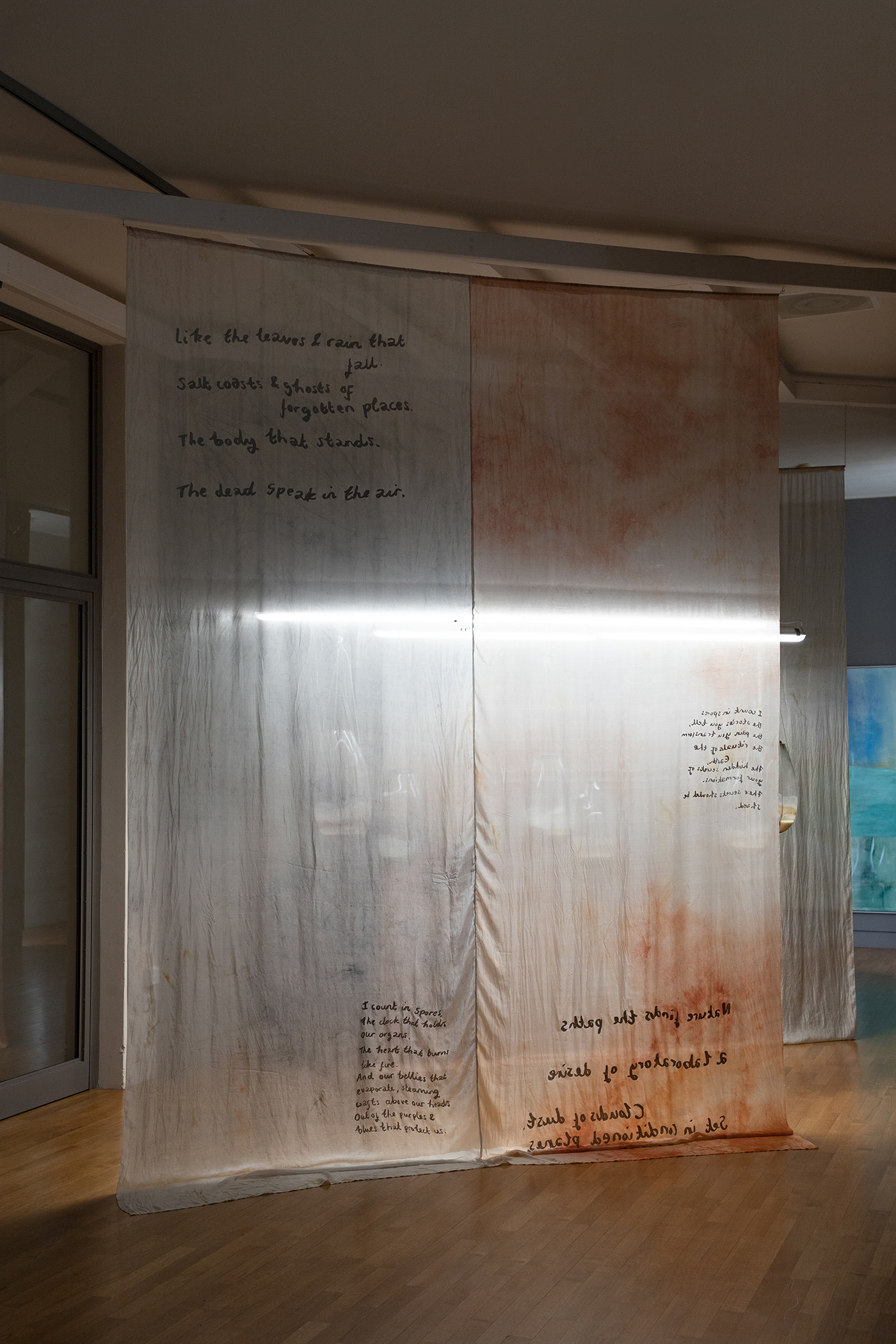
Alice Morey, Conditioning Demands, 2022, Mouth-blown glass, pigments (aegirine, cinnabarite, cavansite, red ochre, malachite, lapis lazuli), canvas, lactic acid bacteria, yoghurt, buttermilk, skyr, lime juice, wax, microfilter, metal wire, chains, hand-dyed silk with screen-printed text. Intallation view, Conditioning Demands, 2022, MEWO Kunsthalle Memmingen. Photography: Sebastian Bühler.
On both sides of the central installation, we see the results of Morey's collaborative painterly technique. Burnt out Blue (2022) and A Map of Tenderness (2022) are two large paintings created by the artist together with the bacteria and spores that colonize the canvas. "Burnt out Blue" is an abstract painting that alternates between earthy reds and turquoise to blue tones from left to right and is strongly reminiscent of Impression, soleil levant 1872) and other impressionist paintings by Claude Monet. With her technique, however, Morey has succeeded where the impressionists unavoidably failed –– in completely eliminating the brushstroke. A Map of Tenderness is also reminiscent of art historical models. Mark Rothko's meditative reflections from the 1950s or the landscapes, colours, and colour gradients of Georgia O'Keefe are called to mind here. The painting is structured by a horizon line that separates the surface into a brown foreground and a yellow, orange background. The background is further dotted with green and blue speckles. Black traces extend at mid-height across both grounds, their origins becoming indiscernible. It is intriguing to trace how the mixture of pigments, spores, and bacteria spread across the canvas and what traces these natural agents left behind. The painting Test One (Malachite) (2022) is presented in a case on the wall. As the name suggests, this is an initial attempt to transform the unprimed canvas through fermentation. The result is a three-dimensional sample that appears porous and crunchy. The work is predominantly green in colour with a mottled pattern of black dots, reminiscent of geological layers of earth or other patterns found in nature. Close by, we find another mouth-blown glass vessel titled Fallen (also 2022) - here presented on a pedestal floating slightly above the ground.
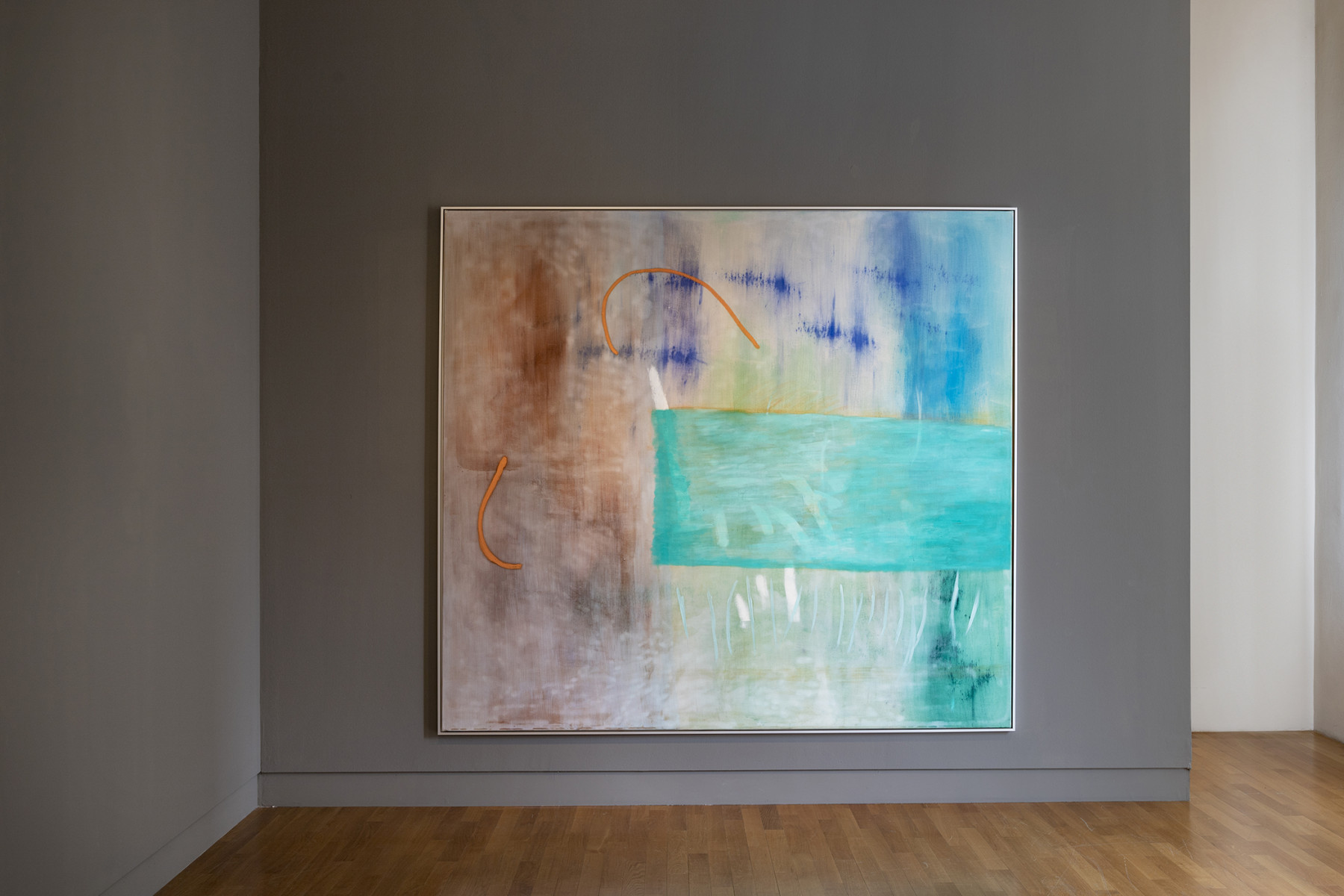
Alice Morey, Burnt out Blue, 2022, Unprimed canvas, pigments (lapis lazuli, cavansite, red and yellow ochre, malachite, thulite, cobalt blue), kaolinitic clay, oil stick, lactic acid bacteria, yoghurt, buttermilk, skyr, lime juice, textile resin, acrylic medium, varnish. 220 x 200 cm. Intallation view, Conditioning Demands, 2022, MEWO Kunsthalle Memmingen. Photography: Sebastian Bühler.
With Conditioning Demands, Morey introduces us not only to the fermentation process but to her artistic process as well. Morey shows how, with, and by whom these works are created and in doing so, she opens up a dynamic field of agents for the production of art besides the dominant "male genius," as Karen Barad describes in her theory of New Materialism with the term "intra-activity". [1] Barad opens up a perspective on matter that is not fixed or given and is certainly not just the result of various external processes: "matter is produced and productive, generated and generative. Matter is agentive, not a fixed essence or property of things. Mattering is differentiating, and which differences come to matter, matter in the iterative production of different differences". In her phenomenology, the agentive intra-actions (as opposed to simple inter-actions, which presuppose the existence of fixed entities or relations) determine the boundaries and properties of the components of phenomena and certain concepts become meaningful. As in Morey's work, Barad further formulates in her agential realist ontology that "phenomena are not the mere result of laboratory exercises engineered by human subjects; rather, phenomena are differential patterns of mattering ('diffractions patterns') produced through complex agential intra-actions of multiple material-discursive practices or apparatuses of bodily productions [...]." Barad's causal intra-actions do not require the participation of humans. In fact, through such practices, the different boundaries between humans and non-humans, culture and nature, science and the social are reconstituted. Intra-actions also operate within the larger material arrangements, as in a series of material practices, creating the agential cut between subject and object. In Morey's interplay of natural and artistic matter all entities are agents. The traditional notion of subordinate entities that are mute and immutable and that all prospects for meaning and change reside in culture is suspended and open to a new formulation.
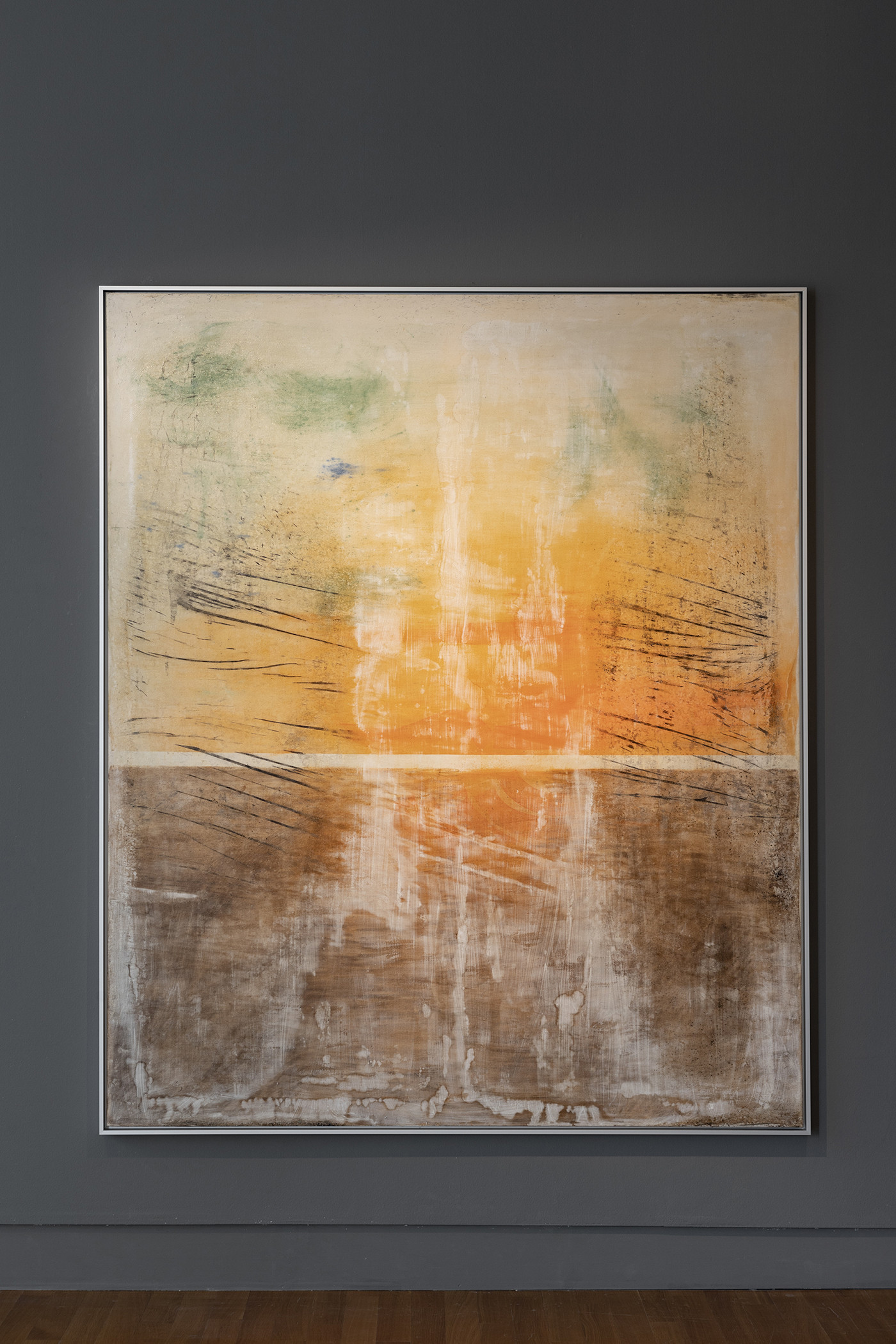
Alice Morey, A Map of Tenderness, 2022, Unprimed canvas, pigments (lapis lazuli, thulite, green earth, cadmium orange), earth from Alentejo, yogurt, buttermilk, skyr, lime juice, textile resin, acrylic medium, varnish. 150 x 180 cm. Intallation view, Conditioning Demands, 2022, MEWO Kunsthalle Memmingen. Photography: Sebastian Bühler.
This exhibition concludes a series of exhibitions titled One thing left to try by curator Lorenzo Graf. Graf sought to interrogate subject configurations with three artistic positions and to further reflect on spaces of agency. In doing this, he critiqued the myth of the artist as master creator and the human’s superior role in planetary existence. The first exhibition of the series was of artist Zishi Han, who questioned narratives of productivity and self-realisation in his dystopian one-room installation titled imagines. Han created a space of ambiguity between self-determination and legibility on the one hand and opacity and complete disintegration in capitalist structures on the other. In Chaoskampf Tutorials, Gabbi Cattani’s exhibition used film to interrogate political and ideological influences, self-determination, and the economic autonomy of the subject.
With her exhibition, Morey frames the possible cultivation of unimagined subjecthood and completes Graf’s series on post-human explorations. The artist makes us pay attention to the tiniest forms of life that shape our ecosystem and, therefore, to the diversity of life. In her collaborative practice, Morey underscores what new formulations of matter and growth can be achieved when humans step down from the role of sole agent.
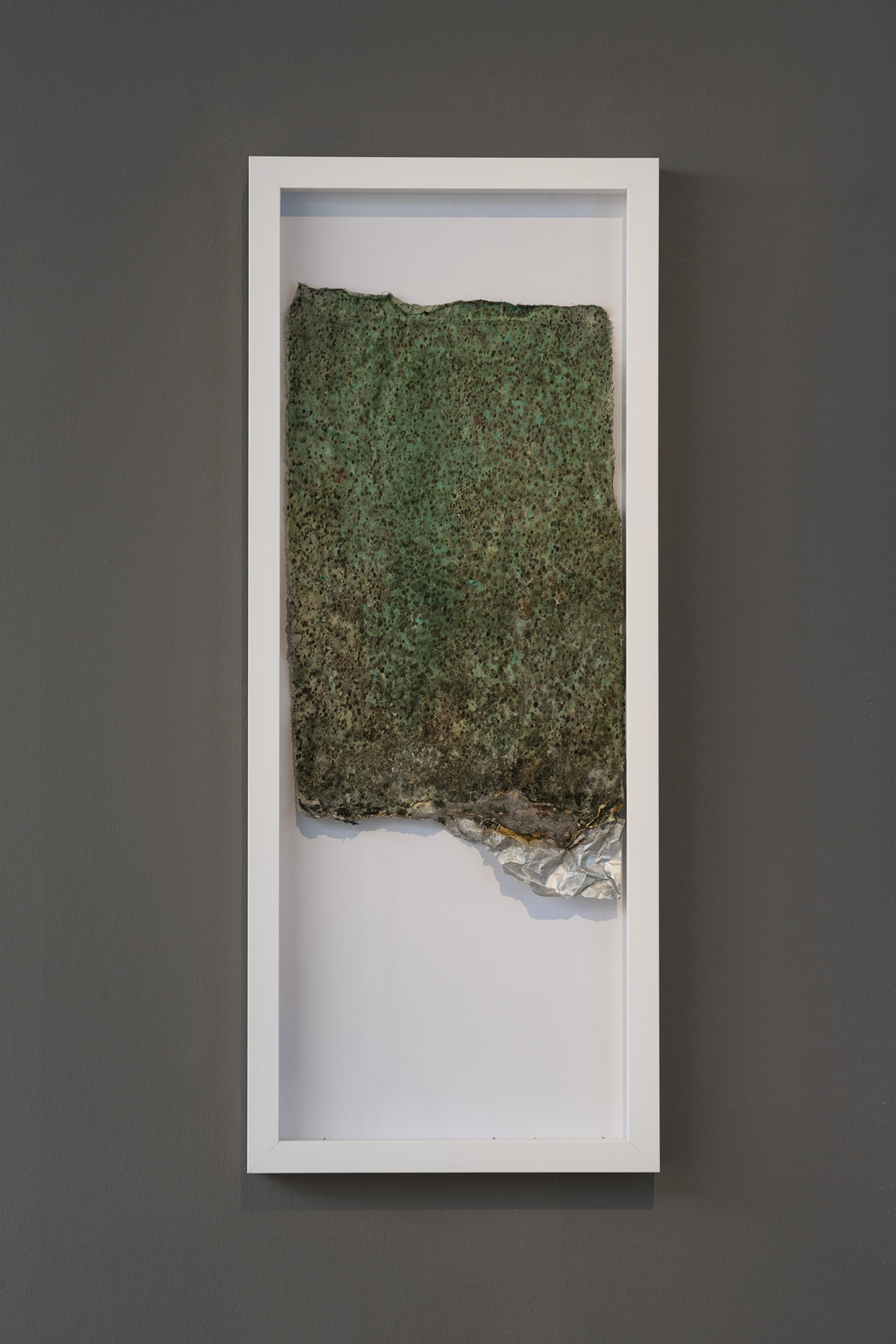
Alice Morey, Test One (Malachite), 2022, Unprimed canvas, aluminum, malachite, lactic acid bacteria, mold, yogurt, buttermilk, skyr, lime juice, textile resin, acrylic medium, varnish. 86 x 34 cm. Intallation view, Conditioning Demands, 2022, MEWO Kunsthalle Memmingen. Photography: Sebastian Bühler.
[1] Karen Barad, Meeting the Universe Halfway: Quantum Physics and the Entanglement of Matter and Meaning, Durham, North Carolina: Duke University Press, 2007
Alice Morey
Conditioning Demands
4/6 — 18/9/2022
MEWO Kunsthalle
Bahnhofstraße 1
87700 Memmingen